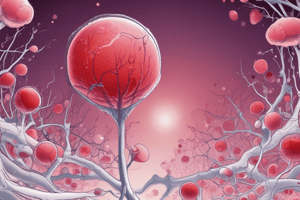Podcast
Questions and Answers
What is the most common age group for Myelodysplastic syndrome (MDS)?
What is the most common age group for Myelodysplastic syndrome (MDS)?
- 40-50 years
- 50-60 years
- >70 years (correct)
- 60-70 years
What are the common symptoms related to anemia in MDS?
What are the common symptoms related to anemia in MDS?
- Fever and arthritis
- Fatigue and decreased exercise tolerance (correct)
- Bleeding and easy bruising
- Recurrent infections
What is a predisposing factor for MDS in younger patients?
What is a predisposing factor for MDS in younger patients?
- Chronic myelomonocytic leukaemia
- Fanconi's syndrome (correct)
- Acute lymphoblastic leukemia (ALL)
- Splenomegaly
What is the significance of splenomegaly, hepatomegaly, and lymphadenopathy in MDS?
What is the significance of splenomegaly, hepatomegaly, and lymphadenopathy in MDS?
What is the incidence pattern of acute lymphoblastic leukemia (ALL)?
What is the incidence pattern of acute lymphoblastic leukemia (ALL)?
What are the common symptoms associated with cytopenias in ALL?
What are the common symptoms associated with cytopenias in ALL?
In MDS, what is the significance of autoimmune manifestations?
In MDS, what is the significance of autoimmune manifestations?
What are the common symptoms of thrombocytopenia in ALL?
What are the common symptoms of thrombocytopenia in ALL?
What are the common symptoms of neutropenia in ALL?
What are the common symptoms of neutropenia in ALL?
Which disease should be considered in younger patients who have had chemotherapy or who have a predisposing factor such as Fanconi's syndrome?
Which disease should be considered in younger patients who have had chemotherapy or who have a predisposing factor such as Fanconi's syndrome?
Which of the following is a common autoimmune manifestation in Myelodysplastic syndrome (MDS)?
Which of the following is a common autoimmune manifestation in Myelodysplastic syndrome (MDS)?
What is a significant difference in the presentation of acute lymphoblastic leukemia (ALL) compared to Myelodysplastic syndrome (MDS)?
What is a significant difference in the presentation of acute lymphoblastic leukemia (ALL) compared to Myelodysplastic syndrome (MDS)?
What is a potential predisposing factor for Myelodysplastic syndrome (MDS) in younger patients?
What is a potential predisposing factor for Myelodysplastic syndrome (MDS) in younger patients?
What age group has a second peak in the incidence of acute lymphoblastic leukemia (ALL)?
What age group has a second peak in the incidence of acute lymphoblastic leukemia (ALL)?
What are the common symptoms associated with cytopenias in Myelodysplastic syndrome (MDS)?
What are the common symptoms associated with cytopenias in Myelodysplastic syndrome (MDS)?
Which of the following is usually seen only in association with chronic myelomonocytic leukaemia under the FAB Cooperative Group classification system for Myelodysplastic syndrome (MDS)?
Which of the following is usually seen only in association with chronic myelomonocytic leukaemia under the FAB Cooperative Group classification system for Myelodysplastic syndrome (MDS)?
In Myelodysplastic syndrome (MDS), what are the common symptoms related to anemia?
In Myelodysplastic syndrome (MDS), what are the common symptoms related to anemia?
What is a possible manifestation of acute illness in Myelodysplastic syndrome (MDS)?
What is a possible manifestation of acute illness in Myelodysplastic syndrome (MDS)?
What are the common symptoms associated with thrombocytopenia in acute lymphoblastic leukemia (ALL)?
What are the common symptoms associated with thrombocytopenia in acute lymphoblastic leukemia (ALL)?
In acute lymphoblastic leukemia (ALL), what are the common symptoms related to neutropenia?
In acute lymphoblastic leukemia (ALL), what are the common symptoms related to neutropenia?



